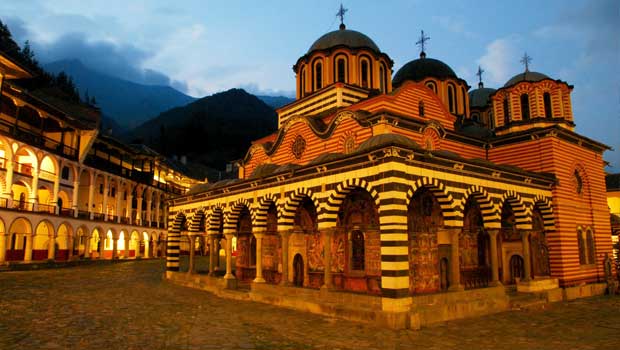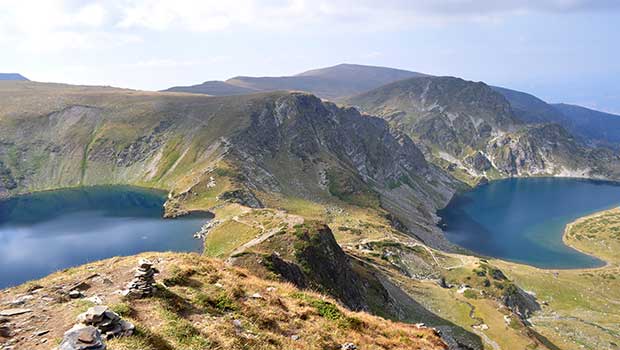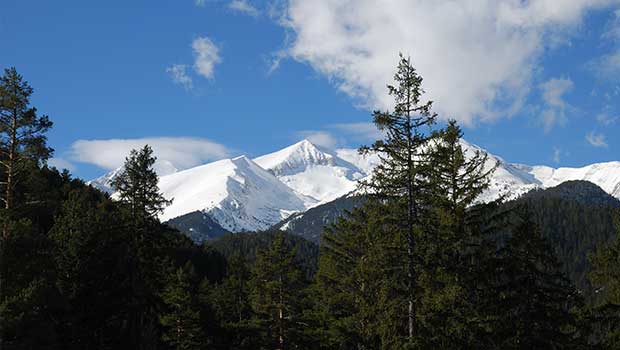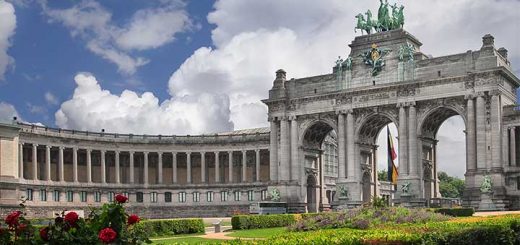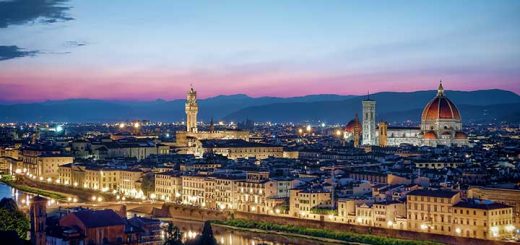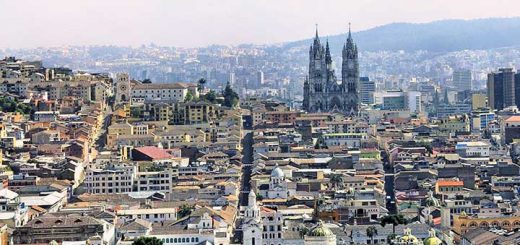Bulgaria – The Pearl of The Balkans
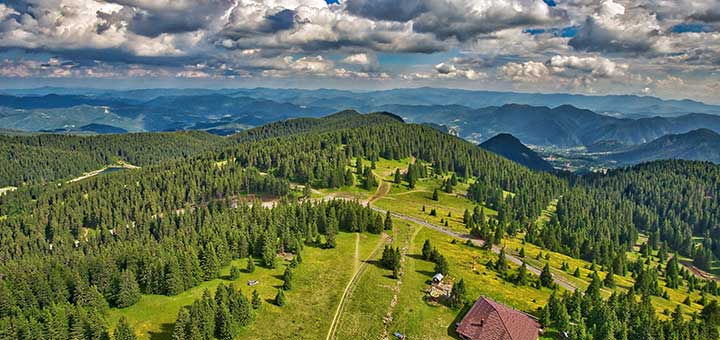
Bulgaria might not be the first country that comes to your mind, when you are planning your next holiday destination, but Bulgaria is definitely and certainly the most sparkling and dazzling gem on the Balkans, a true treasure and a country that can offer exactly all sorts of tourism and hospitality you cannot find anywhere else! Offering glorious beaches with finest sand and sparkling blue seawater, 5-star skiing resorts and experience, fascinating nature heritage, marvelous mountains, ancient monasteries and distinctive culture, Bulgaria is offering you to enjoy an experience that is hard to forget, so you even don’t need to bring souvenirs back (although in this country you can find unique and fancy things). So without further ado, let’s follow the historical and cultural trail of one of the world’s oldest nations in the world.
Sofia
Sofia is the capital city of Bulgaria and the name literary means “wisdom”. Sofia might appear as a bit of intimidating place for many first-time visitors to the country, because of the slightly dynamic and untidy lifestyle you will encounter there, the result of years of poor politics and peculiar and queer culture, but you will soon get used to all this and you will explore that local culture and people are actually providing tourists with hospitality and delight in such amount that you will feel that you have instantly carried away in your cosy and warm home. In addition, much has been done in recent years so the face of the country – Sofia improved in appearance and atmosphere and start feeling like a developed European capital.
With a revitalized heart, Sofia is attracting tourists from all over the world to be explored and enjoyed in every little corner of the city. In fact, this place is surprisingly vibrant, vivid and exciting. Do not miss to enjoy all the public parks and gardens in a sunny and warm day, enjoy the pavement café buzz (café lifestyle is a statement in the country) and dive into a world of one of the most delicious cuisines in the whole world. And just 8 km to the south you can wander around the beautiful Vitosha Mountain that offer breath-taking and awe-inspiring views over the whole city.
Sofia is a very old city, over three thousand years old and you can still find remains of the first inhabitants of Roman and other descent in the city that is full of historical heritage both in the museums and all around the city. Although that during the Ottoman occupation (5 centuries long) many of the historical symbols and monuments are completely destroyed and the presence of many ancient nations in ancient Bulgarian lands is almost deleted, but even today you can explore a lot of remains left by Bulgars, Slavs, Romans and Turks too. However, one of the symbols of the country and one of the architectural highlights of Sofia is the magnificent and awe-inspiring Aleksandar Nevski Cathedral.
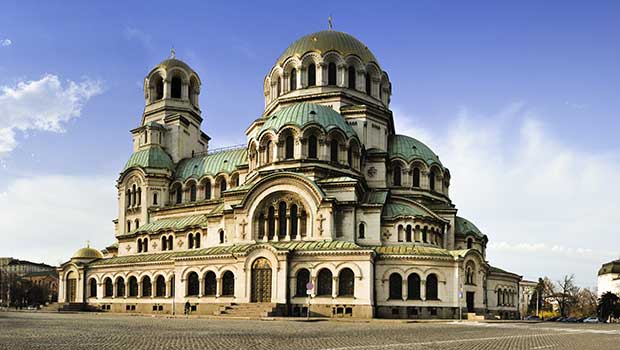
Tourists and travellers will be pleasantly surprised that most of the local sights and must-visits in Sofia are centrally located and within a short walking distance. Whenever you want to take a break from walking around, be sure to stop for a quick coffee break. Cafe and drinking the refreshing hot drink is very popular and a statement amongst Bulgarian people that appreciate and cherish coffee from early morning to the evening. Boulevard Vitosha is a pedestrian zone and consists of hundreds of stores and coffee shops. The Boulevard street leads north to the Church of Sveta Nedelya that is another symbol of Sofia. When in Sofia, be sure you won’t miss:
Sveta Nedelya Church
Right at the heart of the Bulgarian capital is located Sveta Nedelya square that is a pedestrian zone dominated by the ancient Church Sveta Nedelya with a broad dome, distinctive style and vast interior chamber.
The Largo, Party House and Sofia Monument
The Largo is an elongated plaza remaining as a reminder of the Communist rule built in 1950, the monument is a classic example of the Soviet style. Next to The Largo, you can see the Party House that is originally the home of the Communist hierarchy and now serves for the current government. The plaza extends to the Sofia Monument that represents the Goddess of Wisdom Sofia, she is a mother of Faith, Hope and Love, and also a symbol of the Bulgarian capital.
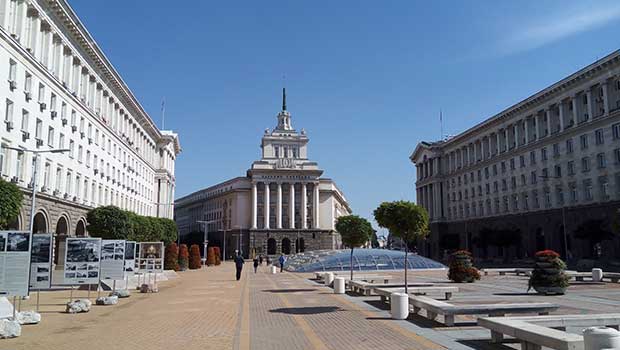
The Banya Bashi Mosque
The Ottoman Mosque is one of the remains from Ottoman occupation and is built in 1576 by Mimar Sinan, who is also a designer of the biggest Mosque in the world – the one in Edirne, Turkey and many emblematic architectural symbols in Istanbul. Today the Banya Bashi Mosque is opened for tourists and works as a museum, but do not get surprised if you see people praying outside five times a day (there is a big percent of Muslims living in Bulgaria). Next to the Mosque, you can see the mineral baths of Sofia that are housed in a breath-taking beautiful yellow building that is currently not open for people.
The Rotunda of St George and Presidency
The oldest church in the Bulgarian capital is the Rotunda of St George that is built in the 4th century. The church is built upon the city’s oldest Roman foundations and is a home to frescoes dating back to 8th century. Right next to the church is the Presidency of the Republic of Bulgaria.
The Archaeological Museum
Housed in a breath-taking and impressively beautiful mosque from the 15th century, the archaeological museum of Sofia is a home to an amazing collection, where the highlights are the magnificent Valchitran Treasure, a Thracian gold cauldron plus cups, one of the oldest gold treasures in the world.
The City Art Gallery
The City Art Gallery is located in the City Garden and is a home to exhibitions and examples of contemporary Bulgarian art.
The Russian Church and Aleksandar Nevski Cathedral
Both the Cathedral and the Russian Church are the architectural highlights of the capital of Bulgaria and the most beautiful monuments in the country. The Russian Church is an outstandingly beautiful golden-domed building with an emerald spire and mosaic-tiled exterior with a heart of dark and mysterious interior. The Russian Church in Sofia is a beautiful and classic example of the breath-taking Russian Empire style.
The nearby Aleksandar Nevski Cathedral is definitely the one place you have to visit in Sofia if there is only one place you can visit. It is not simply one of the finest pieces of architecture in Sofia or Bulgaria, but in the Balkans – a place with many great examples of awe-inspiring architectural symbols. Built between 1882 and 1924, Aleksandar Nevski and has a magnificent structure with dazzling gold domes and semi-domes. The cathedral and its crypt hold a stunning collection of human-sized icons from all over the country.
The National Gallery of Foreign Art
The gallery is housed in a 19th-century building and presents a rich collection of Indian wood-carvings, second-division French and Russian artists, works by Rodin, Chagall, Kandinsky.
Borisova Gradina
Looking for a peaceful place in the heart of the hectic and dynamic capital city of Sofia? Then Borisova Gradina city and a public garden is the perfect place for you to enjoy on a sunny day! Past the magnificent building of Sofia University, the garden is named after the Bulgarian monarch Tsar Boris the Third and is the largest park in Sofia, holding a rich collection of flowers and trees, a few outdoor bars, two football stadiums and a lot of quiet corners for relaxing.
Mount Vitosha
Bulgarians from Sofia are especially proud of the Mountain Vitosha, not the most impressive and highest one in Bulgaria, but definitely, a place that offers amazing views and landscapes. Mount Vitosha is just 8 km south of the city and it is easy to reach with public transport buses. The highest peak of the mountain is the 2290m high Cherni Vrah. Tram number 5 and bus number 61 are both going to help you reach the mountain towards Zlatni Mostove and Stone River.
The Black Sea Coast
Bulgarian coastal resorts are a staple for an authentic Bulgarian holiday, attracting tourists from all around the world for already years. The Bulgarian Black Sea Coast is offering great holiday opportunities with its big and vivid cities and smaller and cosy ones, beaches with fine golden sand and sea waters of all shades of blue. It wasn’t until the 60s when the coastline was developed a lot for mass tourism and since then the resorts just started growing like mushrooms one after another, appearing really sophisticated and exciting, offering the ultimate holiday experience from big resorts to small holiday villages with a quiet and laid back atmosphere. Fine weather is guaranteed for a whole season and you can enjoy the modern and contemporary atmosphere of the big marine cities as well as the cultural and historic appearance of the ancient Sozopol and Nessebar.
Varna
Varna used to be the biggest city on the Black Sea coast for many years but has been recently relocated from its top place by Burgas that is an award-winning Bulgarian marine city and a few times announced for the best place to live in Bulgaria. However, Varna is still a metropolitan city that offers a lot to be done and seen. The city has both a modern and historical atmosphere, a more dynamic and vivid lifestyle and relaxation mode for the tourists. The city is also full of Baroque and classical architecture, shady promenades, a wonderful seaside park. Varna has its fair share as an attractive tourist spot.
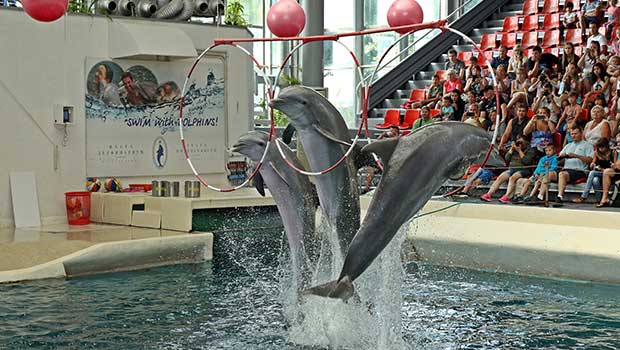
You can experience social life and fun around Nezavisimost square, where the central street of Varna starts from with all its clothing stores and little coffee shops. Right at the beginning of this plaza, you can also enjoy the beautiful building of the Varna’s Opera House. The promenade is starting here to lead you right to the peaceful and beautiful seaside garden. Other highlights of Varna include the domed Cathedral of the Assumption, The Archaeology Museum that houses one of the Bulgaria’s finest collections of antiques and the oldest gold jewelry collection in the whole world that dates back to almost six thousand years, the remains of the 3th century Roman baths, the Navy Museum and, of course, the Delfinarium that offers a family-friendly great experience with dolphin shows two times a day in high season.
Burgas
There is a reason why Burgas is announced as the best city to live in Bulgaria. The city is developing so quickly and is definitely one of the most European-looking cities in the country. Besides the fact that there is much to do and experience in Burgas, the city is also offering an easy access to the ancient cities of Nessebar and Sozopol. The city centre is a wonderful spot for wandering around lined by many little boutiques, bars, coffee shops, but Bourgas’ Sea Gardens are the best place for a walk and enjoying life.
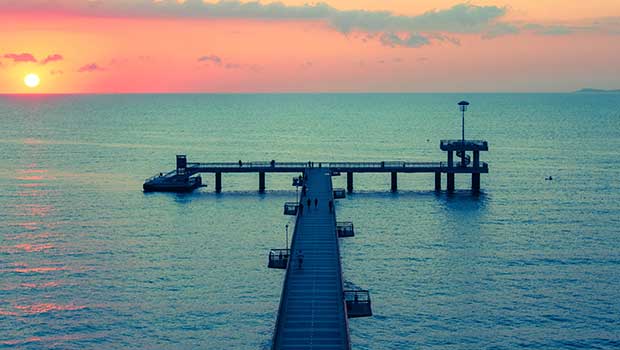
Nessebar
The small town is known as the town of the churches because it houses a lot more than 100 ancient churches and remains. The labyrinthine cobbled streets of Nessebar are always going to lead you to one of the medieval churches, but all of them lead to the Metropolia, the remains of the main ancient church in the region. The town lies on a narrow isthmus that is connected by road to the mainland and geographically it is practically an island. In past, Nessebar (its old name is Mesambria) has been developed to a thriving port with a great importance, remaining an important centre of Greek and Bulgarian culture and the seat of the bishop under the Ottoman rule.
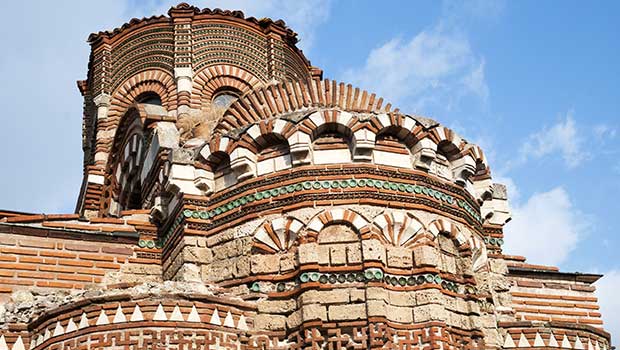
Nowadays, Nessebar is a UNESCO heritage town with its ancient appearance and quiet atmosphere it is attracting thousands of tourists. Some of the many highlights of this otherwise small town include the Archaeological Museum that houses an array of Greek tombstones and medieval icons, the museum Christ Pantokrator that is currently an art gallery, the eleventh-century church St John the Baptist , the Church of Sveti Spas, the ruined Church of St John Aliturgetos and a lot more.
Sozopol
Sozopol is known for its distinctive culture, the cosiness of a small port town and historical heritage. It is also popular as an attractive resort town for many European tourists. The old wooden houses and other examples of distinctive architecture are a big part of the town’s charm. Sozopol is also the oldest settlement in Bulgaria. Make sure to visit the Archeological Museum of the town, the Southern Fortress Wall and Tower Complex. For a vivid and vibrant beach life, make sure to go just a bit north to the beautiful Zlatna Ribka campsite.
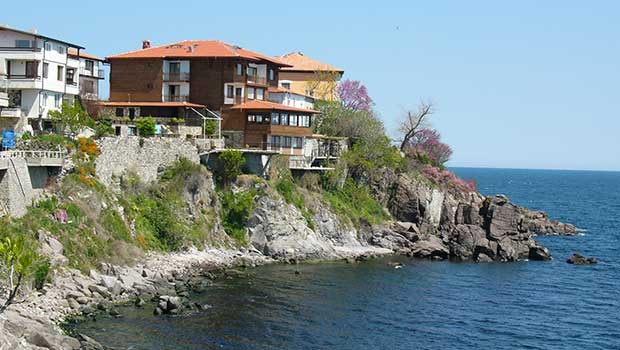
Southern Bulgaria
If you are done enjoying the Bulgarian capital Sofia, then make sure to hit south, where a spectacular route in the skirts of Rila (the highest mountain on the Balkan Peninsula) and the Pirin will lead you to some of the most cultural and beautiful places in the country. Dotted with alpine lakes, luscious forests and awe-inspiring views and landscapes, both Rila and Pirin are worth visiting all year round, with a peaceful and relaxing atmosphere in summer and the 5-star ski resorts in the winter time.
One of the fascinating Bulgarian mountain monasteries is called Rila Monastery and is located in Rila mountain, just 30 km east of the ski resort Bansko. Another important and beautiful place to visit in this part of the country is the Bulgaria’s second city – Plovdiv and just the 30 km distanced Bachkovo Monastery that is an important part of the Bulgaria’s culture, history and the past.
Plovdiv
Plovdiv might be the second largest Bulgarian city, but it is obviously more charming and beautiful than the capital Sofia. The atmosphere in the city is really unique and charming and we are sure that you will enjoy it a lot. The old town is a fascinating part of the city and it embodies Plovdiv’s rich and long history – Thracian fortifications subsumed by Macedonian masonry, overlaid with Roman and Byzantine walls. Plovdiv is, however, not your next museum city, because it has a vibrant and exciting life within its ancient and full of culture walls, with amazing art festivals and trade fairs that are a pretty interesting experience and the biggest in the country, and restaurants and bars that are even better than these in the capital.
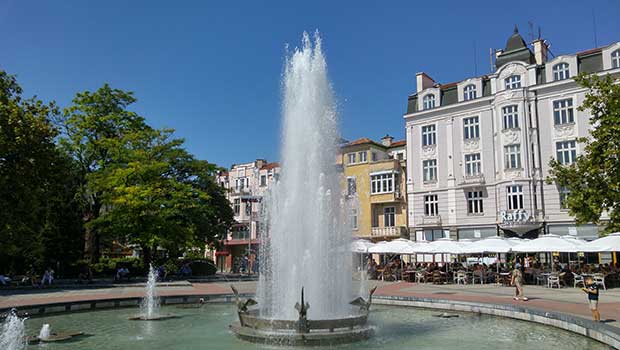
Central Bulgaria
Central Bulgaria is exactly the heart of the Bulgarian culture and history, holding the most the authentic Bulgarian spirit, hospitality and distinctive charm. Welcome to this awe-inspiring and very spiritual part of the country, where the main places you don’t like to miss are the cities of Veliko Tarnovo (a Bulgarian capital in the past), Koprivshtitsa, Karlovo, Kalofer and many other iconic examples of Bulgarian historical and natural heritage.
Stara Planina runs along these ancient and enigmatic Bulgarian lands and it is the cradle of Bulgarian nation for many centuries. The mountain has witnessed the birth of the Bulgarian country and is a home to many forest regions that are known as the Land of the April Rising – a land of a small picturesque mountain town that holds the memory for the Bulgarian bravery and the bravest act of rebellion in world’s history against the Ottoman Empire. With Sofia as a starting point, both Veliko Tarnovo and Koprivshtitsa are easy to reach by car, bus or train.
Veliko Tarnovo
Veliko Tarnovo is one of the most beautiful Bulgarian towns and a former capital of the country. It is known for its amazing historical architecture that is surrounded by the breathtaking valley of Yantra River. Here you can explore hundreds of historical houses that are remaining from the medieval and dramatic past of the city. Veliko Tarnovo is a very special place for the Bulgarian nation because in 1879 met here to draft Bulgarian’s first constitution. Besides the photogenic houses and little labyrinthine streets, the city’s biggest highlight is the Tsarevets Hill, where you can explore and enjoy the medieval fortress, a breath-taking view over the city and a mesmerizing show of light and sound.
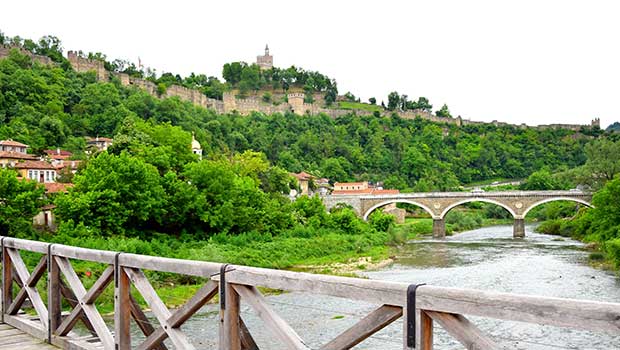
Koprivshtitsa
The small, picturesque and peaceful mountain town of Koprivshtitsa holds a really special place in the heart of each Bulgarian because it is the home to the Bulgarian rebellion against Ottoman rule, associated with the Bulgarian bravery and freedom, visited by the country’s bravest and beloved national heroes. The little town looks almost too lovely to be real, lying in a picturesque valley, where the colourful historical houses are surrounded by picturesque landscapes, an oasis of rural calm.
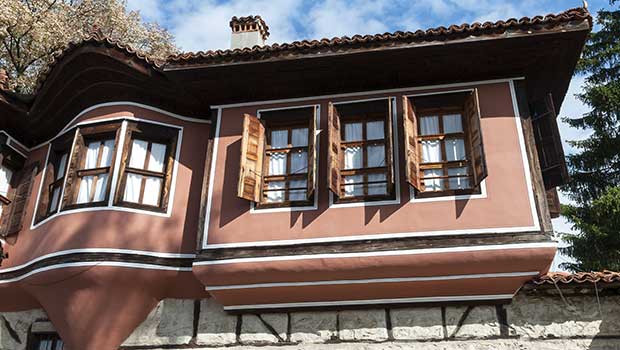
When to visit Bulgaria?
Bulgaria is an amazing country to visit all year round. In wintertime, the country offers amazing opportunities for skiing and snowboarding, while summer is perfect for visiting all the biggest and smaller cities around the country and enjoying the luscious nature. Bulgaria has a continental climate with long and hot summers and pretty hardcore and snowy winters. July and August could be sticky hot in the big cities, while the beach resorts are crowded with tourists, so if you are up to some more peaceful relaxation, but still looking for sunny weather, be sure to visit from May to October.
When in Bulgaria, be sure you are not going to miss:
- Aleksandar Nevski Cathedral in Sofia
- Rila Monastery in Rila mountain
- The Old Quarter in Plovdiv
- Mount Vitosha near Sofia
- Koprivshtitsa
- Beach Bars on the Black Sea coast – you can find the best and most popular ones in Sunny Beach, Golden Sands, St Vlas, Pomorie, Burgas, Varna
- Birdwatching in the areas of Srebarna, Madzharevo, the lakes around Burgas
- Bulgarian cuisine – Do not miss to try Shopska Salad, Bulgarian white cheese, banitsa pastry with ayran, yoghurt, musaka, the alcoholic drink rakia and the strange, but delicious boza.
Essentials
- The population of Bulgaria a bit more than 7 million
- The main currency is Bulgarian Lev
- The official language is Bulgarian, but most of the people are fluent in English, Russian and German
- The international phone code is 00359
- Bulgaria has four airports – in Sofia, Plovdiv, Burgas and Varna. Both Sofia and Burgas airports service a lot of direct flights from Europe, as well as charter flights. Low-cost flights from London and many European capitals are provided to the both airports of Varna and Burgas all year round. The national aircraft is called Bulgarian Air and serves direct flights to most of the European capitals.
- Popular transport in Bulgaria includes trains and buses
- Public transport in Bulgaria is not expensive, but not necessarily the most convenient and fastest one. Be prepared for delayed buses and trains. Traveling by bus is the fastest way to getting around big cities and between major towns and cities. Renting a car in Bulgaria is a great way to explore a lot of the Bulgarian beauty.
- Accommodation in Bulgaria is generally not expensive, although you can find some luxurious resorts on pretty serious price here too. However, if you are on a tighter budget, you can find a great hostel and hotel options in all big cities, while the smaller coastline towns are offering informal room renting or guest house accommodation on a significantly lower than hotel prices. The best campsites are dotted along the coastline and summer only.
- Besides many restaurants with traditional or foreign cuisines, in Bulgaria, you can enjoy sit-down meals in the traditional mehana that offers authentic Bulgarian setting, cuisine and often live music.
- Bulgaria is known for one of the finest wines in the world. Try the heavy reds like Melnik and Mavrud in wintertime and leave the dry whites like Dimyat, Traminer and Chardonnay for summertime.
- Coffee is espresso style, while tea in Bulgaria is almost always herbal.
- Bulgarians are predominantly Orthodox Christians with Muslims of Turkish descent making around 9% of the population.
- Tipping is not obligatory but well appreciated


